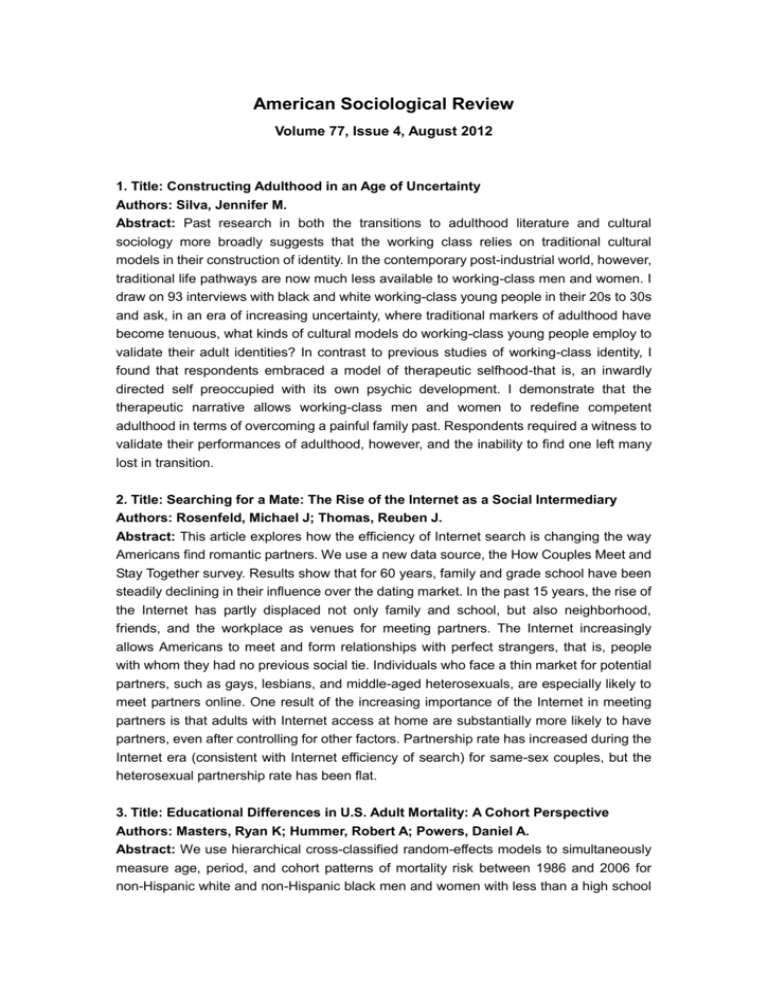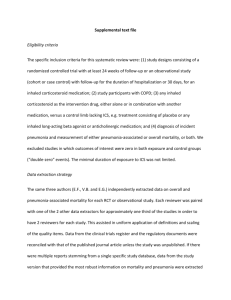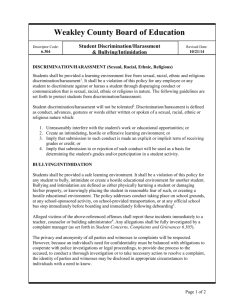American Sociological Review Volume 77, Issue 4, August 2012 1
advertisement

American Sociological Review Volume 77, Issue 4, August 2012 1. Title: Constructing Adulthood in an Age of Uncertainty Authors: Silva, Jennifer M. Abstract: Past research in both the transitions to adulthood literature and cultural sociology more broadly suggests that the working class relies on traditional cultural models in their construction of identity. In the contemporary post-industrial world, however, traditional life pathways are now much less available to working-class men and women. I draw on 93 interviews with black and white working-class young people in their 20s to 30s and ask, in an era of increasing uncertainty, where traditional markers of adulthood have become tenuous, what kinds of cultural models do working-class young people employ to validate their adult identities? In contrast to previous studies of working-class identity, I found that respondents embraced a model of therapeutic selfhood-that is, an inwardly directed self preoccupied with its own psychic development. I demonstrate that the therapeutic narrative allows working-class men and women to redefine competent adulthood in terms of overcoming a painful family past. Respondents required a witness to validate their performances of adulthood, however, and the inability to find one left many lost in transition. 2. Title: Searching for a Mate: The Rise of the Internet as a Social Intermediary Authors: Rosenfeld, Michael J; Thomas, Reuben J. Abstract: This article explores how the efficiency of Internet search is changing the way Americans find romantic partners. We use a new data source, the How Couples Meet and Stay Together survey. Results show that for 60 years, family and grade school have been steadily declining in their influence over the dating market. In the past 15 years, the rise of the Internet has partly displaced not only family and school, but also neighborhood, friends, and the workplace as venues for meeting partners. The Internet increasingly allows Americans to meet and form relationships with perfect strangers, that is, people with whom they had no previous social tie. Individuals who face a thin market for potential partners, such as gays, lesbians, and middle-aged heterosexuals, are especially likely to meet partners online. One result of the increasing importance of the Internet in meeting partners is that adults with Internet access at home are substantially more likely to have partners, even after controlling for other factors. Partnership rate has increased during the Internet era (consistent with Internet efficiency of search) for same-sex couples, but the heterosexual partnership rate has been flat. 3. Title: Educational Differences in U.S. Adult Mortality: A Cohort Perspective Authors: Masters, Ryan K; Hummer, Robert A; Powers, Daniel A. Abstract: We use hierarchical cross-classified random-effects models to simultaneously measure age, period, and cohort patterns of mortality risk between 1986 and 2006 for non-Hispanic white and non-Hispanic black men and women with less than a high school education, a high school education, and more than a high school education. We examine all-cause mortality risk and mortality risk from heart disease, lung cancer, and unpreventable cancers. Findings reveal that temporal reductions in black and white men's and women's mortality rates were driven entirely by cohort changes in mortality. Findings also demonstrate that disparate cohort effects between education groups widened the education gap in all-cause mortality risk and mortality risk from heart disease and lung cancer across this time period. Educational disparities in mortality risk from unpreventable cancers, however, did not change. This research uncovers widening educational differences in adult mortality and demonstrates that a cohort perspective provides valuable insights for understanding recent temporal changes in U.S. mortality risk. 4. Title: Social Movements, Risk Perceptions, and Economic Outcomes: The Effect of Primary and Secondary Stakeholder Activism on Firms' Perceived Environmental Risk and Financial Performance Authors: Vasi, Ion Bogdan; King, Brayden G. Abstract: Although risk assessments are critical inputs to economic and organizational decisionmaking, we lack a good understanding of the social and political causes of shifts in risk perceptions and the consequences of those changes. This article uses social movement theory to explain the effect of environmental activism on corporations' perceived environmental risk and actual financial performance. We define environmental risk as audiences' perceptions that a firm's practices or policies will lead to greater potential for an environmental failure or crisis that would expose it to financial decline. Using data on environmental activism targeting U.S. firms between 2004 and 2008, we examine variation in the effectiveness of secondary and primary stakeholder activism in shaping perceptions about environmental risk. Our empirical analysis demonstrates that primary stakeholder activism against a firm affects its perceived environmental risk, which subsequently has a negative effect on the firm's financial performance. 5. Title: Moving Beyond Deterrence: The Effectiveness of Raising the Expected Utility of Abstaining from Terrorism in Israel Authors: Dugan, Laura; Chenoweth, Erica. Abstract: Rational choice approaches to reducing terrorist violence would suggest raising the costs of terrorism through punishment, thereby reducing the overall expected utility of terrorism. In this article, we argue that states should also consider raising the expected utility of abstaining from terrorism through rewards. We test effects of repressive (or punishing) and conciliatory (or rewarding) actions on terrorist behavior using the newly developed GATE-Israel dataset, which identifies events by Israeli state actors toward Palestinian targets on a full range of counterterrorism tactics and policies from 1987 to 2004. Results show that repressive actions are either unrelated to terror or related to subsequent increases in terror, and conciliatory actions are generally related to decreases in terror, depending on the tactical period. Findings also reveal the importance of understanding the role of terrorists' constituencies for reducing violence. 6. Title: Sexual Harassment, Workplace Authority, and the Paradox of Power Authors: McLaughlin, Heather; Uggen, Christopher; Blackstone, Amy. Abstract: Power is at the core of feminist theories of sexual harassment, although it has rarely been measured directly in terms of workplace authority. Popular characterizations portray male supervisors harassing female subordinates, but power-threat theories suggest that women in authority may be more frequent targets. This article analyzes longitudinal survey data and qualitative interviews from the Youth Development Study to test this idea and to delineate why and how supervisory authority, gender nonconformity, and workplace sex ratios affect harassment. Relative to nonsupervisors, female supervisors are more likely to report harassing behaviors and to define their experiences as sexual harassment. Sexual harassment can serve as an equalizer against women in power, motivated more by control and domination than by sexual desire. Interviews point to social isolation as a mechanism linking harassment to gender nonconformity and women's authority, particularly in male-dominated work settings. 7. Title: Racial Discrimination, Ethnic- Racial Socialization, and Crime: A Micro-sociological Model of Risk and Resilience Authors: Burt, Callie Harbin; Simons, Ronald L; Gibbons, Frederick X. Abstract: Dominant theoretical explanations of racial disparities in criminal offending overlook a key risk factor associated with race: interpersonal racial discrimination. Building on recent studies that analyze race and crime at the micro-level, we specify a social psychological model linking personal experiences with racial discrimination to an increased risk of offending. We add to this model a consideration of an adaptive facet of African American culture: ethnic racial socialization, and explore whether two forms-cultural socialization and preparation for bias-provide resilience to the criminogenic effects of interpersonal racial discrimination. Using panel data from several hundred African American male youth from the Family and Community Health Study, we find that racial discrimination is positively associated with increased crime in large part by augmenting depression, hostile views of relationships, and disengagement from conventional norms. Results also indicate that preparation for bias significantly reduces the effects of discrimination on crime, primarily by reducing the effects of these social psychological mediators on offending. Cultural socialization has a less influential but beneficial effect. Finally, we show that the more general parenting context within which preparation for bias takes place influences its protective effects.






